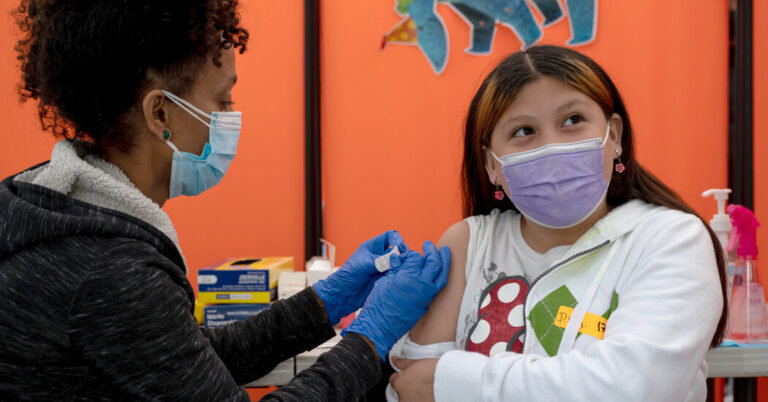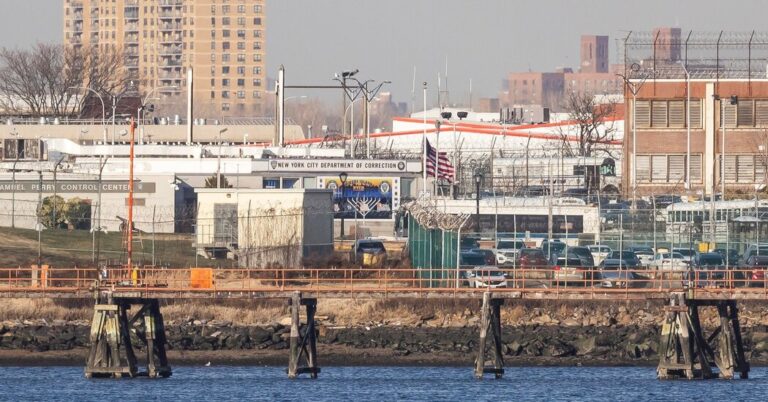Migrant Housing Plans in NYC Are Repeatedly Met With Outrage
Since tens of thousands of migrants began arriving in New York City last year, the administration of Mayor Eric Adams has searched for one place after another to house them: hotels, parking lots, a cruise ship terminal and a pair of giant tents on Randall’s Island among them. Almost every idea has caused an uproar.
Now, the daily stream of migrants feeding the crisis has doubled in size in recent weeks, city officials say. As many as 700 migrants are arriving each day in the city — up from less than half that number since the expiration last Thursday of Title 42, a Trump-era policy that allowed immigration officials to expel some border crossers back to Mexico.
With no clear solutions at hand, the city turned to shelter some migrants in public school gyms starting last week. That plan, like many others before it, was almost immediately met with outrage — not only from activists and human rights groups, but also from public school parents and the ranks of everyday New Yorkers.
On Wednesday, the city began to distance itself from that proposal, too.
More than 67,000 migrants have arrived in New York City since the crisis began. Of those, 41,500 people are currently being cared for by the city, Anne Williams-Isom, the deputy mayor for health and human services, said at a news conference on Wednesday. She said 4,300 people had arrived in just the past week.
That new influx of arrivals has forced the Adams administration to contend with new layers of what was already a humanitarian and economic crisis that the city had spent $1 billion addressing so far, and may cost as much as $4.3 billion through June 2024, according to Ms. Williams-Isom. It has strained Mr. Adams’s relationship with not only New Yorkers but with President Biden.
Last week, thousands of migrants converged on the border ahead of Title 42’s end, but crossings have been significantly down in the past week. Border officials are still processing migrants who have been in custody for days; as of Wednesday, the Border Patrol was holding migrants in custody for about four-and-a-half days, on average. More than 3,800 migrants were released on Wednesday with an immigration court summons.
Mr. Biden has been criticized over his response to immigration by Republicans and Democrats alike in recent weeks, including by Mr. Adams, who said last month that the president had “failed” the city. The Biden administration has moved to restrict the flow of migrants, with new limits on who can apply for asylum in the United States. That would make it all but impossible for many people to qualify if they hadn’t applied for asylum elsewhere.
The arrival of migrants has tested left-leaning cities around the country in particular. In addition to New York, many of the migrants are ending up in places like Chicago, Denver and Washington, D.C., where leaders have sought to emphasize that they are welcome, while at the same time warning that the large numbers of newcomers are straining services.
A few were also aware that the city would guarantee them shelter. (Unlike other large cities, New York is required to give anyone who asks for shelter a place to stay, a guarantee based on decades of court cases.)
Migrants have come in a variety of ways, some with tickets they purchased themselves or with the help of nonprofits, some on buses chartered by other American cities or the state of Texas, and in recent weeks, more are coming via airplane.
For Mr. Adams, the new arrivals have opened a fresh front in the public relations crisis over migrants, as public school parents led a series of protests over the use of school gyms this week. By Wednesday evening, migrants were moved out of a handful of gyms where they had been staying, mostly located in Brooklyn, though the city said that the plan to use about 20 gyms could be revived as needed for temporary overflow.
But Mr. Adams also threw up his hands at the seemingly endless merry-go-round of proposals, outcries and pivots. “Whomever is telling us not to go somewhere, I have one question for you: You tell me where we should go,” Mr. Adams said on Wednesday.
“The number one question I’m asking everyone now,” the mayor continued, “Did you go to Washington to get us more money? What have you done for the migrants? And where would you like for me to house them?”
Ms. Williams-Isom, the deputy mayor, told reporters that the city was facing a serious humanitarian crisis and needed New Yorkers to come together in a spirit of cooperation and problem solving, not armchair quarterbacking.
“We have seen too many criticisms couched in half truths,” she said. “We are looking for constructive, real suggestions, not idle talking points.”
She said that the city was running out of options and that its shelter capacity was full, which had forced it to turn to temporary options like gyms and “large open spaces.”
On Tuesday, protesters gathered outside P.S. 172 in Brooklyn, one of the schools whose gym was designated as emergency housing for migrants. Some protesters arrived as early as 3 a.m., when they believed migrants might begin to arrive.
Gabriela Vizhnag, 50, the mother of a third grader, said she was “not racist or anti-immigrant” because she herself immigrated from Mexico. But she opposed the plan to house people in a school gym with no available showers and only two bathrooms.
“It is not good for the children and it is not humane for the migrants,” she said.
A group of migrants from Venezuela watched the protest from a shelter across the street. One, María Briseño, 38, said she understood why parents were upset.
“Schools should be for children and the city should make an effort to house migrants in other places,” said Ms. Briseño, who came to the United States seven months ago with her husband and two children, who now attend another nearby public school.
Ms. Williams-Isom said the city had requested assistance from mayors and county executives across the state, but when asked by reporters about specific proposals or which municipalities the city had asked for help, she declined to provide details. Instead, she repeatedly said that the city was at the end of its rope. The city applied for $350 million in federal aid, but will receive about $30 million, city officials have said.
“What I want New Yorkers to really understand in this moment is that we are in an emergency and we are at a breaking point in the system,” she said, when asked if the city would house migrants in vacant office spaces.
Activists and legal groups have called on the city to focus on helping people find permanent housing, but New York is in the grip of a long-running housing crisis, and its voucher program has been plagued with troubles.
On Wednesday, the Brooklyn borough president, Antonio Reynoso, called on the mayor, the New York City Council and Gov. Kathy Hochul, a Democrat, to take legal action to make thousands of unlisted vacant apartments available for New Yorkers living in shelters, a move he said would free up shelter space for migrants.
Speaking in Harlem on Wednesday, Mr. Adams appeared exasperated by having to explain to New Yorkers that the influx of migrants had created a crisis in the city. He said the city had, in some ways, been a victim of its own success.
“One of the biggest impediments to resolving this issue is that people have not really accepted the fact that this is a crisis,” the mayor said. “Because we have managed it well, people have the belief, ‘Well it can’t be that bad.’ No, it’s bad.”
The mayor said the city was expecting 13 to 15 busloads of migrants in the next several days.
Mr. Adams said that housing migrants at hotels had broader implications for the city, beyond just the cost of putting them up.
“Instead of monies coming from people who are visiting us and spending in our tourism, in our Broadway plays, instead of them using those hotels, we’re using those hotels,” Mr. Adams said.
He then tried to emphasize the seriousness of the situation by explaining that half the hotels in the city were occupied by asylum seekers, a figure that turned out to be inaccurate. The Hotel and Gaming Trades Council, which represents workers at hotels with 70 percent of the city’s rooms, said about 3,500 rooms were being used to house asylum seekers. There are between 125,000 and 130,000 hotel rooms in the city, it said.
City officials later clarified that 40 percent of the hotels suitable to house migrants had been booked. Advocates have said that means that hotels should still be an option.
“I’m worried they want to use temporary circumstances that will garner public outcry as a way of nudging Washington,” said Shelly Nortz, deputy executive director for policy for the Coalition for the Homeless. “It wouldn’t be the first time public officials made shelter an unattractive option to send a message to other officials or the migrants themselves.”
Most arriving migrants have said that they were eager to find work; they can become eligible to work legally if they apply for asylum. The process can take a long time, however, so many are finding jobs to support themselves in the underground economy instead.
Marisol Moreno, 55, came to New York six months ago, and has been living in the Holiday Inn in the Financial District for two months. She said she felt “so grateful that this city has supported me and allowed me to stay here.”
She said she also empathized with exasperated city officials and even those who might be unhappy with the arrival of migrants, because her native country, Ecuador, had struggled to provide for migrants fleeing Venezuela.
“I get it. It’s terribly hard for a country or a state to admit thousands of immigrants. It’s a heavy burden,” Ms. Moreno said. “But I believe in us as well, as immigrants. I believe that if we put our heads together, work hard, we can create something worthy here in the United States.”
Wesley Parnell, Raúl Vilchis, Eileen Sullivan and Karen Zraick contributed reporting.
Check out our Latest News and Follow us at Facebook
Original Source







